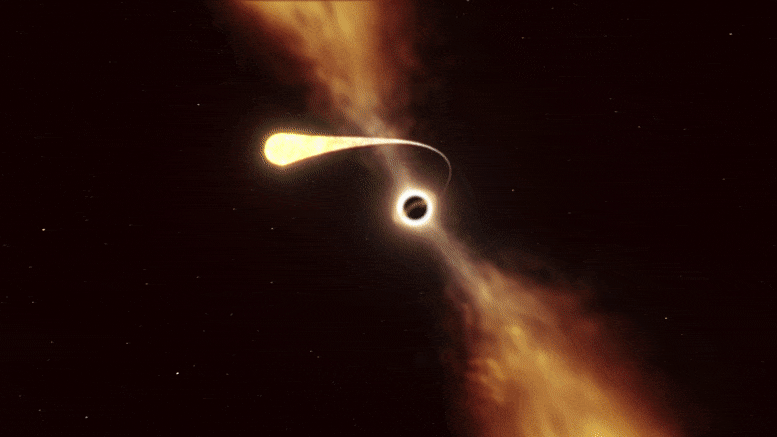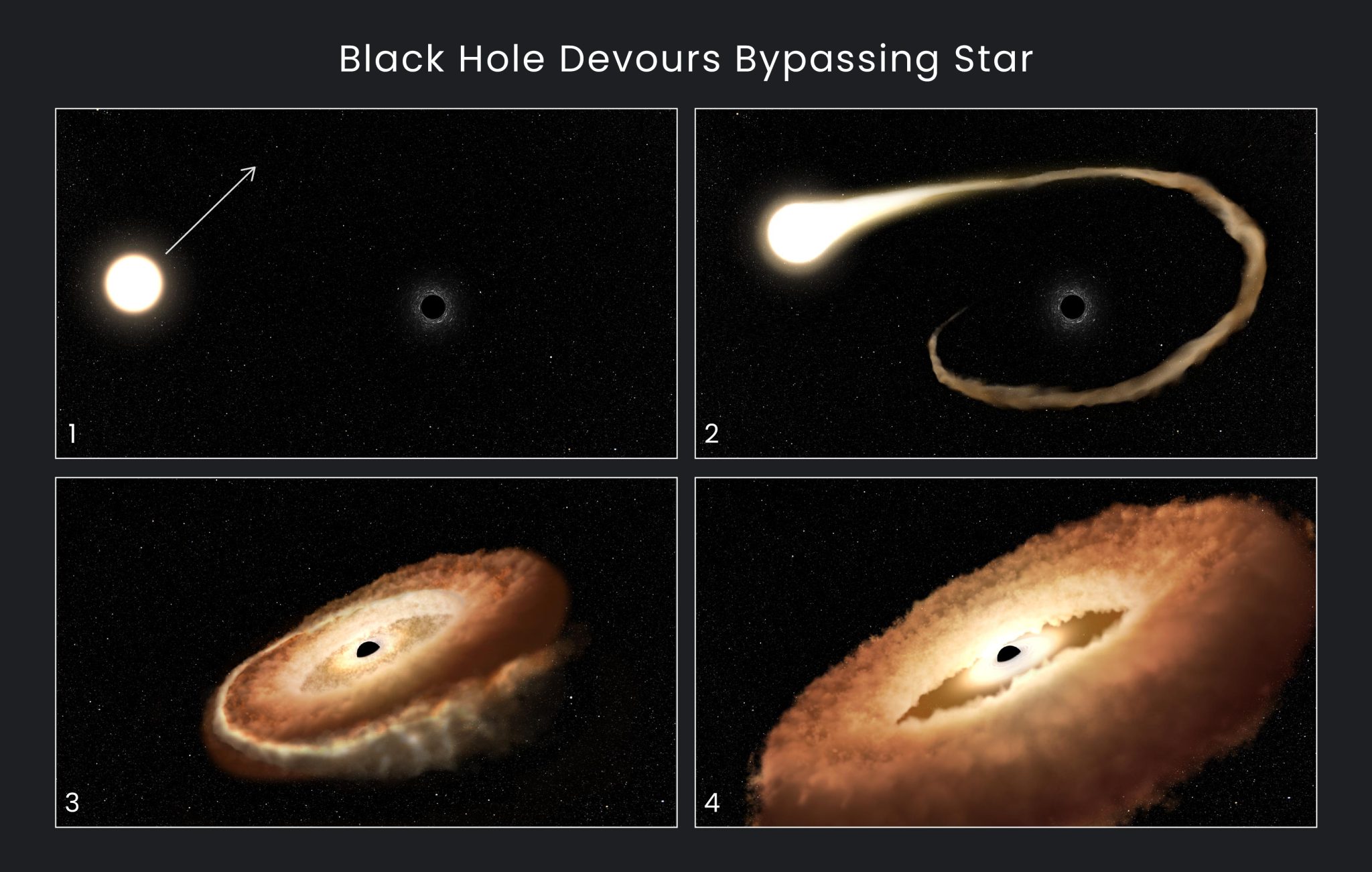
This animation depicts a star experiencing spaghettification as it’s sucked in by a supermassive black hole during a ‘tidal disruption event’. Credit: ESO/M. Kornmesser
A Deep Gravitational Sinkhole Swallows Unlucky Bypassing Star
Black holes have such a voracious gravitational pull that they even swallow light. This makes them hungry monsters lurking in the eternal darkness. There’s no escape if you happen to stumble across one in the inky blackness of space. That’s no worry for astronauts who have yet to travel farther than the Moon. But entire stars can face that peril if they wind up in the wrong place at the wrong time.
Hubble astronomers got a front-row seat to such an interstellar demolition derby when they were alerted to a flash of high-energy radiation from the core of a galaxy 300 million light-years away. Like a police officer arriving quickly at the scene of an accident, Hubble vision was trained on the mayhem before the collision was over. Hubble is too far away to see the doomed star getting sucked in. Instead, Hubble astronomers took the fingerprints of starlight coming from the mishap. These spectra tell a forensic story of a star falling into a cosmic blender. It was shredded, and pulled toward the black hole like a piece of stretched taffy. This process formed a donut-shaped ring of gas around the black hole with superheated gas bleeding out in every direction. About 100 insatiable black holes have been observed to date.

This sequence of artist’s illustrations shows how a black hole can devour a bypassing star.
1. A normal star passes near a supermassive black hole in the center of a galaxy.
2. The star’s outer gasses are pulled into the black hole’s gravitational field.
3. The star is shredded as tidal forces pull it apart.
4. The stellar remnants are pulled into a donut-shaped ring around the black hole, and will eventually fall into the black hole, unleashing a tremendous amount of light and high-energy radiation.
Credit: NASA, ESA, Leah Hustak (STScI)
Hubble Finds Hungry Black Hole Twisting Captured Star Into Donut Shape
Black holes are gatherers, not hunters. They lie in wait until a hapless star wanders by. When the star gets close enough, the black hole’s gravitational grasp violently rips it apart and sloppily devours its gasses while belching out intense radiation.
Astronomers using NASA’s Hubble Space Telescope have recorded a star’s final moments in detail as it gets gobbled up by a black hole.
These are termed “tidal disruption events.” But the wording belies the complex, raw violence of a black hole encounter. There is a balance between the black hole’s gravity pulling in star stuff, and radiation blowing material out. In other words, black holes are messy eaters. Astronomers are using Hubble to find out the details of what happens when a wayward star plunges into the gravitational abyss.
Hubble can’t photograph the AT2022dsb tidal event’s mayhem up close, since the munched-up star is nearly 300 million light-years away at the core of the galaxy ESO 583-G004. But astronomers used Hubble’s powerful ultraviolet sensitivity to study the light from the shredded star, which includes hydrogen, carbon, and more. The spectroscopy provides forensic clues to the black hole homicide.
Astronomers using NASA’s Hubble Space Telescope have recorded a star’s final moments in detail as it gets gobbled up by a black hole. Credit: NASA’s Goddard Space Flight Center, Lead Producer: Paul Morris
About 100 tidal disruption events around black holes have been detected by astronomers using various telescopes. NASA recently reported that several of its high-energy space observatories spotted another black hole tidal disruption event on March 1, 2021, and it happened in another galaxy. Unlike Hubble observations, data was collected in X-ray light from an extremely hot corona around the black hole that formed after the star was already torn apart.
“However, there are still very few tidal events that are observed in ultraviolet light given the observing time. This is really unfortunate because there’s a lot of information that you can get from the ultraviolet spectra,” said Emily Engelthaler of the Center for Astrophysics | Harvard & Smithsonian (CfA) in Cambridge, Massachusetts. “We’re excited because we can get these details about what the debris is doing. The tidal event can tell us a lot about a black hole.” Changes in the doomed star’s condition are taking place on the order of days or months.
For any given galaxy with a quiescent supermassive black hole at the center, it’s estimated that the stellar shredding happens only a few times in every 100,000 years.
This AT2022dsb stellar snacking event was first caught on March 1, 2022, by the All-Sky Automated Survey for Supernovae (ASAS-SN or “Assassin”), a network of ground-based telescopes that surveys the extragalactic sky roughly once a week for violent, variable, and transient events that are shaping our universe. This energetic collision was close enough to Earth and bright enough for the Hubble astronomers to do ultraviolet spectroscopy over a longer-than-normal period of time.
“Typically, these events are hard to observe. You get maybe a few observations at the beginning of the disruption when it’s really bright. Our program is different in that it is designed to look at a few tidal events over a year to see what happens,” said Peter Maksym of the CfA. “We saw this early enough that we could observe it at these very intense black hole accretion stages. We saw the accretion rate drop as it turned to a trickle over time.”
The Hubble spectroscopic data are interpreted as coming from a very bright, hot, donut-shaped area of gas that was once the star. This area, known as a torus, is the size of the solar system and is swirling around a black hole in the middle.
“We’re looking somewhere on the edge of that donut. We’re seeing a stellar wind from the black hole sweeping over the surface that’s being projected towards us at speeds of 20 million miles per hour (three percent the speed of light),” said Maksym. “We really are still getting our heads around the event. You shred the star and then it’s got this material that’s making its way into the black hole. And so you’ve got models where you think you know what is going on, and then you’ve got what you actually see. This is an exciting place for scientists to be: right at the interface of the known and the unknown.”
The results were reported during a press conference on January 12, 2022, at the 241st meeting of the American Astronomical Society in Seattle, Washington.
The Hubble Space Telescope is a project of international cooperation between NASA and ESA. NASA’s Goddard Space Flight Center in Greenbelt, Maryland, manages the telescope. The Space Telescope Science Institute (STScI) in Baltimore, Maryland, conducts Hubble and Webb science operations. STScI is operated for NASA by the Association of Universities for Research in Astronomy, in Washington, D.C.
Article From & Read More ( Black Hole's Deep Gravitational Sinkhole Twists Unlucky Star Into Donut Shape - SciTechDaily )https://ift.tt/NquZEpQ
Science
No comments:
Post a Comment